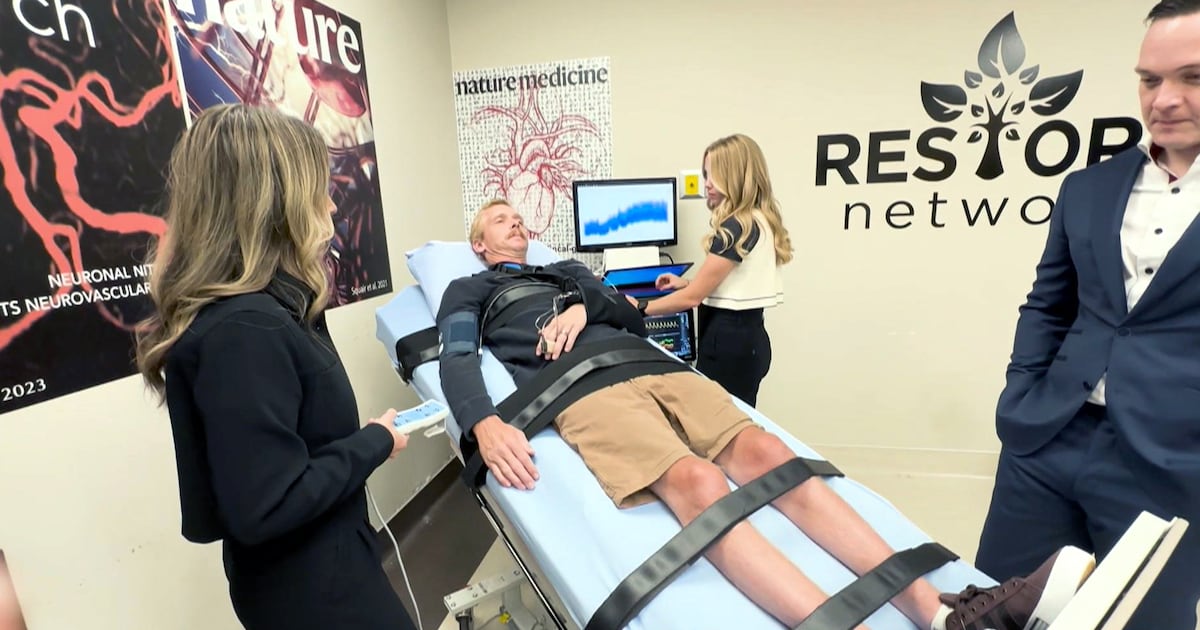Health
New Implant Restores Blood Pressure Control for Spinal Injury Patients

A groundbreaking implantable system has been shown to stabilize blood pressure in patients with spinal cord injuries, according to research published in the scientific journals Nature and Nature Medicine. This innovative therapy, developed by teams at multiple universities, including the University of Calgary, has the potential to significantly improve the quality of life for individuals affected by such injuries.
The study involved 14 participants across four clinical trials conducted in Canada, Switzerland, and the Netherlands. Research indicates that spinal cord injuries can disrupt the connection between the brain and the body, leading to severe blood pressure fluctuations. “Blood pressure is a profound issue after a spinal cord injury, both highs and lows,” explained Aaron Phillips, an associate dean at the University of Calgary Cumming School of Medicine, who contributed to the study.
The consequences of these fluctuations can be serious. Low blood pressure may cause fainting and fatigue, while high blood pressure increases the risk of strokes. Phillips noted that long-term blood pressure instability could also lead to cardiovascular disease.
One participant, Cody Krebs, experienced a spinal cord injury after a serious car accident in 2022 that resulted in damage to his C6 and C7 vertebrae. This injury has left Krebs unable to regulate his blood pressure effectively. “I get really lightheaded and dizzy, and my ears can start ringing,” he shared.
As part of the research trial, Krebs received an implantable device designed to help manage his blood pressure. “This device is implanted around the spinal cord and delivers a low electrical current to essentially replace the signal the brain would normally provide,” said Dr. Fady Girgis, a neurosurgeon and associate professor at the University of Calgary. He emphasized that while surgery carries risks, these devices have been used safely for years and can help patients avoid reliance on blood pressure medications.
The implant works using externally controlled electrical currents, although a new prototype allows for delivery without the need for a remote. Krebs reported significant improvements in his daily life since receiving the device. “It’s helped me get back into work because I’m not exhausted all the time,” he said. “If I have it on throughout the day, I find I can spend more time in the evenings without being tired and having to go to bed early.”
The company behind this neurostimulation system has received FDA approval to launch a pivotal trial involving approximately 20 neurorehabilitation and neurosurgical research centers across Canada, Europe, and the United States. This next phase could pave the way for wider adoption of this promising technology, potentially transforming the treatment landscape for those with spinal cord injuries.
The results of this research highlight the importance of continued innovation in medical treatments and the potential to enhance the lives of patients suffering from serious health conditions. As the medical community awaits the outcomes of the upcoming pivotal trial, the early results demonstrate a significant step forward in addressing blood pressure regulation for spinal cord injury patients.
-

 Education3 months ago
Education3 months agoBrandon University’s Failed $5 Million Project Sparks Oversight Review
-

 Science4 months ago
Science4 months agoMicrosoft Confirms U.S. Law Overrules Canadian Data Sovereignty
-

 Lifestyle3 months ago
Lifestyle3 months agoWinnipeg Celebrates Culinary Creativity During Le Burger Week 2025
-

 Health4 months ago
Health4 months agoMontreal’s Groupe Marcelle Leads Canadian Cosmetic Industry Growth
-

 Science4 months ago
Science4 months agoTech Innovator Amandipp Singh Transforms Hiring for Disabled
-

 Technology3 months ago
Technology3 months agoDragon Ball: Sparking! Zero Launching on Switch and Switch 2 This November
-

 Education3 months ago
Education3 months agoRed River College Launches New Programs to Address Industry Needs
-

 Technology4 months ago
Technology4 months agoGoogle Pixel 10 Pro Fold Specs Unveiled Ahead of Launch
-

 Business3 months ago
Business3 months agoRocket Lab Reports Strong Q2 2025 Revenue Growth and Future Plans
-

 Technology2 months ago
Technology2 months agoDiscord Faces Serious Security Breach Affecting Millions
-

 Education3 months ago
Education3 months agoAlberta Teachers’ Strike: Potential Impacts on Students and Families
-

 Science3 months ago
Science3 months agoChina’s Wukong Spacesuit Sets New Standard for AI in Space
-

 Education3 months ago
Education3 months agoNew SĆIȺNEW̱ SṮEȽIṮḴEȽ Elementary Opens in Langford for 2025/2026 Year
-

 Technology4 months ago
Technology4 months agoWorld of Warcraft Players Buzz Over 19-Quest Bee Challenge
-

 Business4 months ago
Business4 months agoNew Estimates Reveal ChatGPT-5 Energy Use Could Soar
-

 Business3 months ago
Business3 months agoDawson City Residents Rally Around Buy Canadian Movement
-

 Technology2 months ago
Technology2 months agoHuawei MatePad 12X Redefines Tablet Experience for Professionals
-

 Business3 months ago
Business3 months agoBNA Brewing to Open New Bowling Alley in Downtown Penticton
-

 Technology4 months ago
Technology4 months agoFuture Entertainment Launches DDoD with Gameplay Trailer Showcase
-

 Technology4 months ago
Technology4 months agoGlobal Launch of Ragnarok M: Classic Set for September 3, 2025
-

 Technology4 months ago
Technology4 months agoInnovative 140W GaN Travel Adapter Combines Power and Convenience
-

 Science4 months ago
Science4 months agoXi Labs Innovates with New AI Operating System Set for 2025 Launch
-

 Top Stories2 months ago
Top Stories2 months agoBlue Jays Shift José Berríos to Bullpen Ahead of Playoffs
-

 Technology4 months ago
Technology4 months agoNew IDR01 Smart Ring Offers Advanced Sports Tracking for $169










